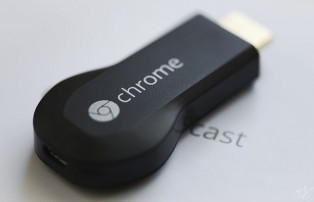We’ve covered presentation tech here on the Ethos3 blog before, but of course, the world of technology is ever-changing. In particular, the standard for the visual dimension of presentations seems to undergo as much flux as any electronics niche, since it is influenced mostly by the powerful consumer television market.
For any demonstration small enough to not require a standalone projector, it seemed at one point that the HDMI cable would be the primary solution. Indeed, the various revisions to the HDMI standard have extended its usefulness, and due to strong consumer demand and industry support, the interface remains virtually unchallenged for dominance in the space. The cable form factor, on the other hand…
Enter the streaming stick.
Google Chromecast ($29.99)
With the advent of the Chromecast, the days of spending your per diem on a ridiculously long HDMI cable or stretching your power cord clear across the room in search of the sole open outlet were over. The first of its kind and a trailblazer in the streaming marketplace, the Chromecast is still running strong years after its introduction, in part due to its clever construction.
Because of Google’s wildly popular and versatile Android/Chrome platforms, the Chromecast is able to dump off much of the computing duties to its paired devices, allowing the USB-powered unit to be as technically nimble as possible. (The Chromecast does not have a discrete remote).
As great as it is to cut down on your cable management, streaming sticks would be as useful as regular sticks to presenters if they didn’t get your slides from Point A to Point B. Luckily, the Chromecast integrates with Google Slides, so you can control your presentation with your mobile device, including your iPad or iPhone, as long as you can download the Google Drive app.
If you’re tied to your computer, though, have no fear – the Chromecast’s best virtue is probably its ability to “cast”, or stream, any Google Chrome tab in its entirety. That means whether you’re using Powerpoint Online, Prezzi, or Slideshare, all you have to do is pull your presentation up in your browser and hit the cast button. It’s a great feature that the Chromecast’s competitors have been sure to emulate.
Roku Stick ($47.00)
A popular spin-off of the Roku brand of set-top streaming machines, the Roku Stick matches the form factor of the Chromecast (if not the color), and offers a more comprehensive functionality for consumers.
Since Roku doesn’t have a browser of its own, however, the closest this device can offer to tab-casting is screen mirroring. The technology is a bit less crisp, since it is in beta, and it’s not exactly baked in to the platform. Getting it to work requires a dive into the Roku’s settings, and that’s only if you have one of the handful of compatible devices. None of those included products runs on iOS or OS X, by the way, so if you’re an Apple loyalist, you’re out of luck when it comes to presentations on Roku.
Amazon Fire Stick ($39.00)
The Amazon Fire TV Stick is an interesting blend between Roku and Google’s offerings. On the one hand, it benefits from a very large existing platform like the Chromecast, but then again, it’s more laser-focused on the entertainment market like the Roku Stick.
The result is a rather mixed bag for presenters. It does include its own remote, but given its dependence on Miracast, the shaky technology behind Roku’s screen mirroring feature, it’s impossible to say how well it will work from device to device. Amazon’s official support page claims that the Fire TV’s screen mirroring will work with Android (and Fire Phone, but the less said about that, the better) devices going back to version 4.2. That will cover devices that are up to 3 years old, but Amazon doesn’t guarantee the compatibility of any models in particular, and the Miracast standard only officially supports Android 4.4 and up. Once again, Apple devices are not supported, except by sketchy third-party apps, making the Fire TV Stick a difficult option to recommend.
Conclusion
Although the Chromecast is, more or less, a bare bones media platform, it’s also a very versatile device — with functionality its streaming stick competitors can’t yet match. As far as its usability for presenters, the lack of a physical remote is no great hurdle, as many of us likely have our favorites already. But the dependence on a standalone Wi-Fi network may be an issue when presenting in unfamiliar places — it’s a problem the products with direct-wireless technology Miracast baked in would be great at solving, if their compatibility weren’t so limited. Still, finding a Wi-Fi password could be a lot easier than stringing cords all over the place, and if that’s how you feel, then the Chromecast is really the only way to go.
For more on presentation tools, check out Ethos3 Founder Scott Schwertly’s SlideShare blog.

